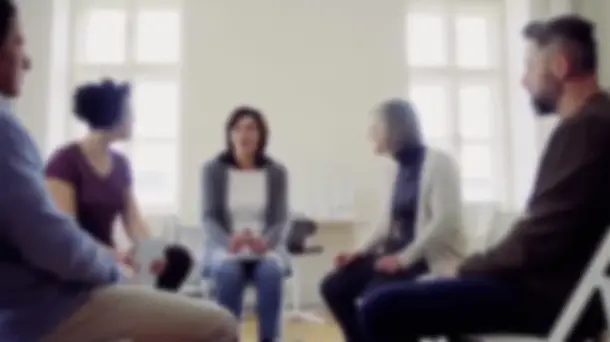Welcome to Narcotics Anonymous
What is our message? The message is that an addict, any addict, can stop using drugs, lose the desire to use, and find a new way to live. Our message is hope and the promise of freedom.

“When new members come to meetings, our sole interest is in their desire for freedom from active addiction and how we can be of help.”
It Works: How and Why, “Third Tradition”
Is NA for me?
This is a question every potential member must answer for themselves. Here are some recommended resources that may be helpful:
Need help for family or a friend?
NA meetings are run by and for addicts. If you're looking for help for a loved one, you can contact Narcotics Anonymous near you.
Subscribe to NAWS Emails
Sign up to receive Just for Today and SPAD daily meditation emails, as well as NAWS News, NAWS Updates, and more.
Never before have so many clean addicts, of their own choice and in free society, been able to meet where they please, to maintain their recovery in complete creative freedom.
Basic Text, “We Do Recover”
Recovery Quicklinks:
Service Quicklinks:
Narcotics Anonymous sprang from the Alcoholics Anonymous Program of the late 1940s, with meetings first emerging in the Los Angeles area of California, USA, in the early Fifties. The NA program started as a small US movement that has grown into one of the world's oldest and largest organizations of its type.
Today, Narcotics Anonymous is well established throughout much of the Americas, Western Europe, Australia, and New Zealand. Newly formed groups and NA communities are now scattered throughout the Indian subcontinent, Africa, East Asia, the Middle East, and Eastern Europe. Narcotics Anonymous books and information pamphlets are currently available in 49 languages.
Information About NA
Daily Meditations
Just for Today
December 26, 2025 |
Never-Failing Power |
| Page 376 |
| “As we learn to trust this Power, we begin to overcome our fear of life.“ |
| Basic Text, p. 25 |
| We are people accustomed to placing all our eggs in one basket. Many of us had one particular drug of choice that was our favorite. We relied on it to get us through each day and make life bearable. We were faithful to that drug; in fact, we committed ourselves to it without reservation. And then it turned on us. We had been betrayed by the only thing we had ever depended on, and the betrayal left us floundering. Now that we've stumbled into the rooms of recovery, we may be tempted to rely on another human being to meet our needs. We may expect this from our sponsor, our lover, or our best friend. But dependence on human beings is risky. They fall short of perfection. They may be on vacation, sleeping, or in a bad mood when we need them. Our dependence must rest on a Power greater than ourselves. No human force can restore our sanity, care for our will and our lives, or be unconditionally available and loving whenever we are in need. We place our trust in the God of our understanding, for only that Power will never fail us. |
| Just for Today: I will place my trust in a Power greater than myself, for only that Power will never let me down. |
A Spiritual Principle a Day
December 26, 2025 |
Communication Is Complicated! |
| Page 372 |
| “Taking a look at the difference between what we are saying, what is heard, and how people are responding to us can be the beginning of real change in all our relationships.“ |
| Living Clean, Chapter 7, “Principles, Practice, and Perspective” |
| It doesn't take much cleantime to figure out that our communication skills could use some work. We find ourselves increasingly ready to connect, really connect, with other people. We'll have to learn to build bridges, not burn them down. Being better communicators–and better humans, for that matter–will mean discarding some old patterns and adopting some new ones. Indulging in gossip is one of those old habits of communication we may want to rethink. We may have believed we bonded with others by sharing information that wasn't ours to share. Even when the news seems harmless, gossiping makes us seem untrustworthy. We learn to resist the urge to fill in every gap in any conversation with rumor, speculation, and innuendo. We get more comfortable with some breaks in our conversations and learn the value of listening more and speaking less. We adopt a new habit of asking questions and practicing empathy and open-mindedness as we hear others' points of view. Some of us suffer from overthinking, not oversharing. We second-guess the wisdom of speaking up, keeping what's on our minds to ourselves instead. We may think we're being considerate, but withholding our experience and ideas often keeps others at arm's length. We might come off as shallow or stuck-up when maybe we're just shy. Sure, there's risk involved in putting our ideas on the table, but that vulnerability enables us to connect. To complicate matters, communication involves so much more than talking and listening. All of those nonverbal cues we exchange–facial expressions, body language, eye contact, touch–all add meaning. Communication is complicated! Often the best strategy is to check that we understand correctly or have been understood. |
| ——— ——— ——— ——— ——— |
| Today I'll take a closer look at how I communicate with others and identify one or two areas to work on. |
Do you need help with a drug problem?
“If you’re new to NA or planning to go to a Narcotics Anonymous meeting for the first time, it might be nice to know a little bit about what happens in our meetings. The information here is meant to give you an understanding of what we do when we come together to share recovery…”
Subscribe to NAWS Emails
Sign up to receive NAWS Updates and NAWS News emails as well as Just for Today and SPAD daily emails.



